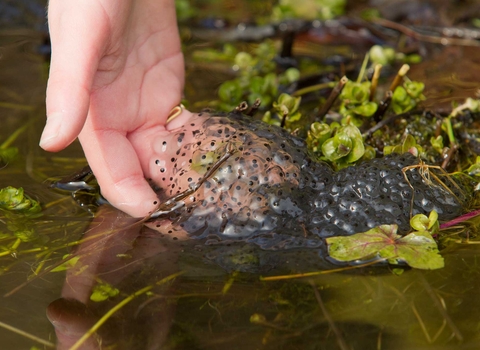Got a wildlife question?
Find detailed answers to frequently asked wildlife questions below.
Injured wildlife
As a conservation organisation, Surrey Wildlife Trust cannot treat sick or injured wildlife. If you find an animal that is trapped or hurt, please contact Leatherhead based wildlife rescue charity Wildlife Aid, Harper Asprey Wildlife Rescue in Camberley or the RSPCA.
Finding a baby bird on the ground
In most instances we recommend leaving a baby bird alone if you find one on the ground. To find out why and what to do if you suspect a baby bird is injured or in danger, please visit our baby bird FAQ page.
Identifying a plant or animal
We are unable to come out to your home. If possible please email a photograph and description to info@surreywt.org.uk or visit our species explorer page.
You can also get in touch via Facebook or Twitter
To submit a species record, please visit the Surrey Biodiversity Information Centre (SBIC) page
Wildlife gardening advice
Detailed wildlife gardening advice on everything from ponds to pests can be found in the wildlife gardening section of our website
Moving frog & toad spawn
Detailed information about frog and toad spawn can be found on the Amphibian & Reptile Trust website.
Cutting back a bush or tree without harming wildlife
The cutting and pruning hedges should always take place outside of the main breeding period (between September and February). Nesting birds are fully protected by law and it can be a criminal offence if a nest is harmed.
Deterring pests without harming wildlife
Each garden is a miniature ecosystem. The creatures within it determine what thrives, survives, deteriorates or dies. By using the wildlife friendly pest control measures listed on our wildlife gardening pages you can achieve equilibrium in your outdoor space.
Fungi picking & foraging on our sites
The picking of fungi is prohibited on Trust managed land. For more information and advice about other forms of foraging, please visit our fungi FAQ page
Carrying out an ecological survey
Surrey Wildlife Trust Ecology services carries out professional ecological services for local authorities, companies and individuals. Please visit our dedicated ecology services website below for further information
What is Ash Dieback
First confirmed in the UK in 2012, ash dieback, also known as 'Chalara' or Chalara ash dieback, is a fatal disease of ash trees caused by a fungus called Hymenoscyphus fraxineus. The disease has spread across Europe and the UK.
For information about Ash Dieback on Trust managed sites and how to recognise the disease, please visit out Ash Dieback FAQ page
Reporting & preventing wildfires
If you see an unattended or wild fire, please report it straight away. Don’t assume someone else has reported it.
- Don’t attempt to tackle fires that can’t be put out with a bucket of water
- Get to a safe place
- Note the location of the fire
- Call 999 and ask for the Fire & Rescue Service
- Give as much information as you can
For information on preventing wildfires and how you can help, visit our wildfire FAQ page
Reporting a wildlife crime
If you witness a suspected wildlife crime in action call 999 immediately.
In all other instances, call 101 for the non-emergency service and ask to speak to your local Wildlife Crime Officer. To remain anonymous, call Crimestoppers on 0800 555 111.
For more information about types of wildlife crime and the laws protecting wildlife in the UK, visit our FAQ page

